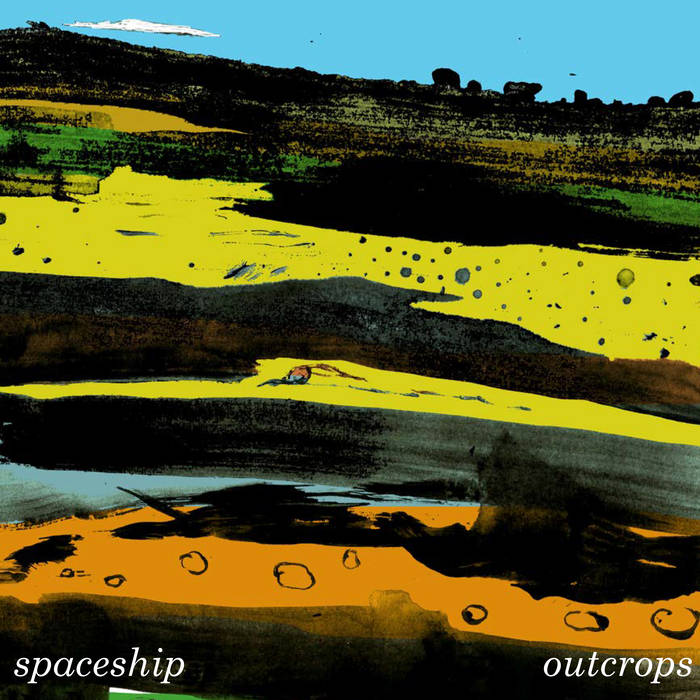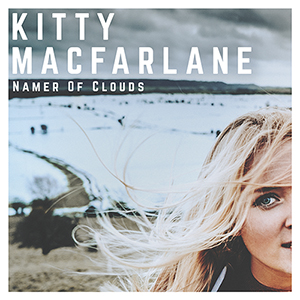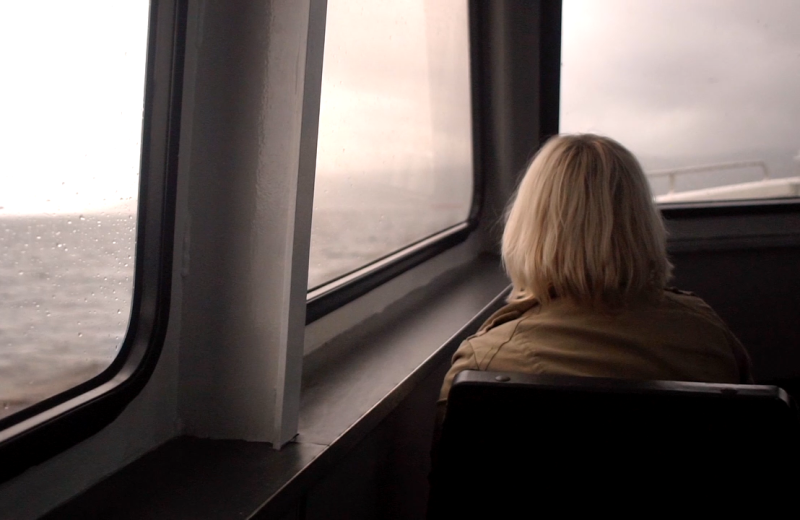Review and Interview by Paul Scraton:
I first heard the music of Kitty Macfarlane on her EP ‘Tide & Time’ a couple of years ago and was immediately struck by both the beauty of her voice and the spirit of place to be found within the lyrics. ‘Wrecking Days’ was the standout song, with its stories of beachcombers stalking the shore, and it was great to hear it again in a new arrangement on Macfarlane’s debut album ‘Namer of Clouds’, which is released by Navigator Records this week.
All the tracks on ‘Namer of Clouds’ speak to our relationship with landscape, place and the environment, whether it is Macfarlane’s native Somerset on ‘Man, Friendship’ or the story of the last of the Sardinian sea silk seamstresses on ‘Sea Silk’. This is an album of haunting, lyrical music that asks the listener to consider her place in the world, the beauty to be found there and the consequences of our negligence or disinterest. On ‘Wrecking Days,’ Macfarlane describes what is left behind by the tide, and if there is poetry in the image of cuttlefish bones, there is certainly a warning in what else can be found on the beach, from the discarded fishing tackle to the plastic bottle tops, resting among the seaweed and stones.
This is thoughtful songwriting, whether in the original compositions or new arrangements of traditional folk ballads. The album closes with an artistic collaboration across the ages: on Inversnaid Macfarlane reworks a 150 year-old poem by Gerald Manley Hopkins about the importance of preserving the wilderness for future generations, a task that is as important now as it ever was.
You can hear ‘Man, Friendship’ and see the official music video below, and we are extremely grateful to Kitty Macfarlane for answering some of our questions about the album, her songwriting in general, and the importance of place in her work:
From the moment I heard Wrecking Days on the Tide & Time EP, it seemed clear to me that there is a distinct sense of place in your songwriting. What role do you feel place has in your work, and which places most influenced the songs on the new album?
'Place' isn't just a geographical location. It's bound up in the stories that span hundreds of years, the changing face of a landscape over time (and our part in that), the traditions that tie people to the land, and the inexplicable way certain corners of the world can make you feel. At school we are taught geography, history, art, chemistry... as if they are separate things. For me, songwriting pulls it all together. My album couldn't help but be a bit of a tribute to Somerset, where I am from – the scenery creeps into my songs almost by accident, along with the stories of the people and creatures that live there. That said, there is also a song set on a small Mediterranean island off Sardinia, and another which is a song-setting of a poem by Manley Hopkins about a Scottish stream. I wanted it to be an album of songs loosely bound by mankind's relationship with the land.
Of all the places you have written about or the landscapes that have otherwise inspired your work, which is your favourite?
Again and again my songs return to the beautiful and ancient Somerset Levels. They are a large low-lying wetland area of peat and clay with an eerie timeless quality - perhaps something to do with their yearly renewal by ruthless flooding. The Levels hold stories of ancient people preserved in the peat; of wandering Neolithic people on their wooden trackways; of Alfred the Great, King of Wessex, conquering the Danes against all odds from his hiding place on the isle of Athelney; of the disastrous floods of 1607 where thousands of people perished; of the basket-makers and thatchers, the elver fishermen and cider producers. Man, Friendship deals with our steadily changing climate, the cruel floods across Sedgemoor and what is left for humanity to cling to when all else is washed away.
In February this year I went down to Shapwick Heath nature reserve on the Levels to watch the starling murmurations at dusk. I was surprised to find hundreds of other people with the same idea, and there we all stood, wrapped up in coats and scarves, while a hundred thousand winged bodies swelled above us, bound by some magnetic tether, a pulsing leviathan in the sky. I wrote Starling Song about this uncanny phenomenon, but it was more than just a spectacle for me - it felt like a moment of immense connection with humanity.
Glass Eel is a on the surface a song about the eels that have historically filled Somerset's waterways. Their colossal, near 4000 mile migration from the Sargasso Sea to Europe is one of science's great mysteries, and there are many parts of their enigmatic life cycle that we still don't understand. The song is about the constant motion of the Earth and everything on it – how we are all compelled by the same centrifuge that drives the eel. But the European Eel is now critically endangered, due to a loss of intertidal and wetland habitats, overfishing, and man-made obstacles to their mammoth journey. I think the plight of the lowly eel is strangely metaphorical for the problems our own species faces – our fragmentation of the land with motorways, dams and weirs is like the international fissures wrought on a global scale, our gluttony and overfishing relates to our wider exploitation of the environment, and the eel's journey recalls our own questions of rights to land, migration, and belonging.
Do you find yourself most inspired by places you know well, or have travels - on tour for instance, or otherwise - given you new places to write about?
There's a definite appeal to writing about places that are familiar, as they become entwined with so many unaccountable emotions and memories. But there is inspiration everywhere and it's exciting to think of how open-ended songwriting can be. For one of the songs on the album, Sea Silk, I travelled to Sant'Antioco, a small island off Sardinia to meet and interview an elderly Italian lady who is one of the last remaining people to create 'sea silk' in the authentic and traditional way. Sea silk is a very fine thread spun from the filaments or 'byssus' of giant endangered clams that live in the Mediterranean. It has extraordinary qualities which turn it from a dull brown to a brilliant gold in sunlight. The art of spinning sea silk has been practised for centuries, and is passed down through generations of women in Sant'Antioco – traditionally, it cannot be sold for profit, but must only be given away. It crops up throughout history here and there – Nefertiti's bracelets, King Solomon's robes, even perhaps Jason's golden fleece... but is shrouded in mystery. Chiara Vigo is a remarkable woman who has devoted her life to this art form, and it was incredibly special to hear her talk about how she learnt it from her grandmother as a girl.
To me it spoke of the historical relationship between women and textiles and the land, and the important roles women throughout the world have quietly performed in the background that are rarely acknowledged by the history books. I love knitting, and part of that is the feeling of connection with generations of women before me. I don't actually speak Italian, and Chiara doesn't speak English, which made for an interesting interview (luckily I brought a friend who could translate!) but when we showed each other our own knitted creations, it felt like we shared a common tongue. A recording of Chiara's rich italian speaking voice opens the song, along with part of a soft chanting folk song that she sang to us, that coincidentally happened to be in the right key... it all felt spookily preordained!
In the album notes it says that "the album is augmented by all kinds of 'found' sound." Can you tell us a bit more about this, and how you think this helps route your songs in the places you are writing about?
I really wanted the album to feature little pieces of the places that inspired the songs. We borrowed a portable mic and took field recordings in various locations – the chaotic waterfowl recorded at dawn from a hide on the Avalon Marshes set behind Starling Song (I saw my first Bittern while recording this!), the babbling brook with its restful birdsong to accompany Inversnaid, the crash of Sardinian waves behind Sea Silk. Morgan's Pantry is a traditional song about the malicious 'Morgans' that live in the Bristol Channel, that allegedly come to the shore at the foot of a hidden waterfall on the North Coast. We set out to track down this waterfall, only accessible at low tide, from an Ordnance Survey map, and recorded the rush of water falling onto the rocks, which then formed part of the song's soundscape. Using found sound seemed to pay tribute to the people and places in the songs, and made the process feel like a sort of collaboration between myself and the wild.
What are your upcoming plans? Tour dates you'd like to tell us about... oh, and when will you be coming to play in Berlin?
I'm just about to set off on a big UK tour! It starts on the 4th October in the Lake District, then I'm off all over the country for 23 gigs in all. The two biggies though are my album launch shows in Bristol (10th November) and London Kings Cross (13th) – these will be really special evenings where I'll be playing with a full band with lots of treats and surprises... Unfortunately no European gigs yet, but I'd love to come and play in Berlin one day!










